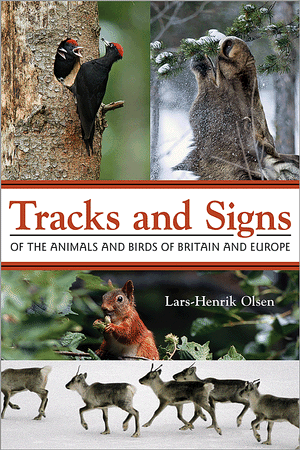 Tracks and Signs of the Animals and Birds of Britain and Europe
Tracks and Signs of the Animals and Birds of Britain and EuropeLars-Henrik Olsen
Princeton University Press | 2013
272 pp. | 16 x 23.5 cm | 600 colour illustrations & photographs. 25 maps
Paperback flexibound | £17.95 / $29.95 | ISBN: 9780691157535
This is a very well produced, abundantly illustrated guide to the tracks and signs of 175 species of European mammals and birds, bound in a field-friendly, flexible cover. The first hundred pages are thematic sections on bird and mammal tracks, scat, feeding signs, nests and dens, pellets and feathers, while the remainder of the book comprises species accounts for mammals. The first part of the book is the most useful in identification since, for example, different types of owl pellet and comparative illustrations of footprints are presented in the same place.
The only guide to tracks and signs I have on my shelves is the Collins Guide (Bang & Dahlstrom 1974), acquired in the late 1970s. Surprisingly, this (in a 2001 2nd edition) and the Hamlyn Guide (Brown et al. 1992) have remained the standard European field guides, despite their age. How does Olsen's guide measure up? Over the period of a few months last autumn, I made an effort to consult Bang & Dahlstrom and Olsen on every track, trail or sign I encountered.
The first test was a badger sett and obvious runs on nearby farmland. Bang & Dahlstrom cover this well, with a good description, clearly differentiating it from a fox's earth, and photos (monochrome in the original, colour in the newer edition). Olsen goes a little further, with a lot more text and images of bedding, as well as the quintessential sett.
Cutting the hay on our village green in August revealed a network of Field Vole runs. These are well depicted in my Bang & Dahlstrom, replaced by a colour photograph of winter runs in the newer edition, similar to the one used in Olsen.
Next a Goldfinch feather – easy enough to identify without a guide. None of the guides included it. Olsen has four pages dedicated to feathers of a dozen species, but not this one. He does, however, provide a lovely photograph that shows just how the Waxwing got its name.
Our garden is full of Bank Voles and Wood Mice, but which of them has been at the Hazel cobs? According to Bang & Dahlstrom, who provide excellent comparative illustrations, this neat round hole that looks to have been made by a mini tin-opener was the work of the Wood Mouse. Confusingly, Olsen has strikingly similar paintings, but with different incisor marks to illustrate the work of the Bank Vole.
 |
| Goshawk-killed Woodpigeon, Norfolk, December 2013 |
By springtime, the first crocuses were attracting the attention of House Sparrows. All credit to Bang & Dahlstrom for including a colour photograph that captures this perfectly. Oddly, this seems to have disappeared from the newer edition, nor does Olsen mention this behaviour.
To be fair, the old Collins and Hamlyn books are true field guides – compact, portable and laid out for field reference – whereas Olsen is more of an introduction to tracks and signs for home use. Including, as it does, plenty of photographs of the animals that make tracks, as well as distribution maps, it will be particularly useful for those who do not already have a field guide to mammals. Over half the book is dedicated to species accounts of this sort rather than comparative analysis of tracks; arguably, in an identification guide, this space could have been better used for tracks themselves. This is a book aimed more at a European then a UK readership, with eight pages devoted to Red Squirrels and just one to Grey, and the inclusion of large carnivores like Lynx, Wolf and Bear, as well as ungulates like Moose and Musk Ox.
Nevertheless, there is much to enjoy here, from the new illustrations to the excellent photographs. A useful addition to the literature on tracks and signs, which adds to the previously available guides. Sadly, we still do not have a European reference equivalent of Mark Elbroch's superb Mammal tracks and signs: a guide to North American species.
References
Bang, P. & Dahlstrom, P. (1974) Animal tracks and signs. Collins: London. 240 pp.
Bang, P. & Dahlstrom, P. (2001) Animal tracks and signs. Oxford University Press: Oxford. 264 pp.
Brown, R.W., Lawrence, M.J., & Pope, J. (1992) Animal tracks, trails and signs. Hamlyn: London. 320 pp.
Elbroch, M. (2003) Mammal tracks and signs: a guide to North American species. Stackpole Books: Mechanicsburg, PA. 780 pp.
No comments:
Post a Comment